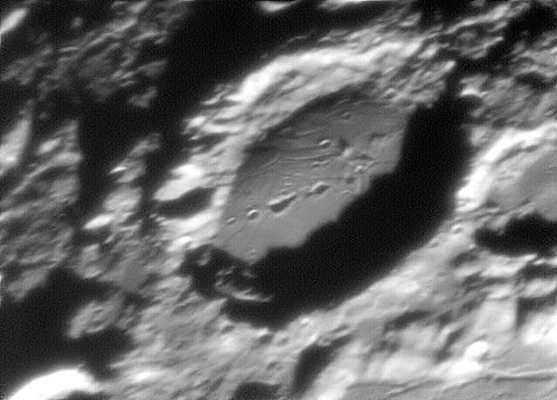Mersenius is in the second rank of lunar craters. Not a must-see like Copernicus, Plato or Gassendi, but a good crater with more interesting features than are obvious. Mersenius is 84 km wide and about 2.3 km deep. But as has been known for more than 125 years, Mersenius appears to have a domed floor so its depth may be more varied than for normal craters. In his 1876 book, The Moon, Neison quoted Schmidt as saying that Mersenius had a "strongly-convex" floor and estimated its center to be 450 m higher than near the walls. This remarkable low sun image by Benoit Schillings gives little evidence for a gradually decreasing elevation westward from the center of the floor, but does show a shadow/depression where the west wall meets the floor. It seems unlikely that this alone is 450 m of relief, but then all these shadow measurements are ancient - are there no modern measurements of this crater's geometry? The line of overlapping craters on the floor are aligned with Imbrium, and thus may be distant secondaries from that basin-forming impact. The image also reveals more delicate rilles on the crater's floor than I have seen on any other Earth-based image. These are very difficult to image or observe - even the Great Schmidt of Athens saw only two, and they were "very difficult." Small pyroclastic deposits have also been detected around the rilles. Mersenius must be another floor-fractured crater.
Technical Details:
Taken with an 18 inch F/4.5 newtonian, double barlow with a firewire 640x480 camera; combination of
about 150 frames. Image processing (image registrration etc...) done with home-made software which
on top of doing frame selection and alignement, distorts the images to counter the distortion induce
by the seeing - this helps a lot for the image quality. With a normal regular best fit stack, you
will always have a better resolution at or near the registration point. My algorithm does a
distortion of the whole image to get an overall best fit for the whole image, not just for a single
point.
Related Links:
Benoit Schillings Web Page
Lunar Orbiter View
|
Yanvar' Fevral' Mart Aprel' Mai Iyun' Iyul' Avgust Sentyabr' Oktyabr' Noyabr' Dekabr' |
|
Publikacii s klyuchevymi slovami:
Moon - Luna - Lunar Photo of the Day - LPOD
Publikacii so slovami: Moon - Luna - Lunar Photo of the Day - LPOD | |
Sm. takzhe:
Vse publikacii na tu zhe temu >> | |
